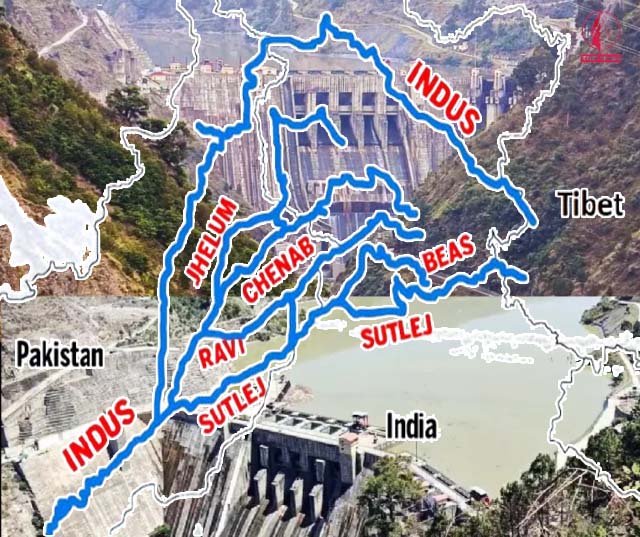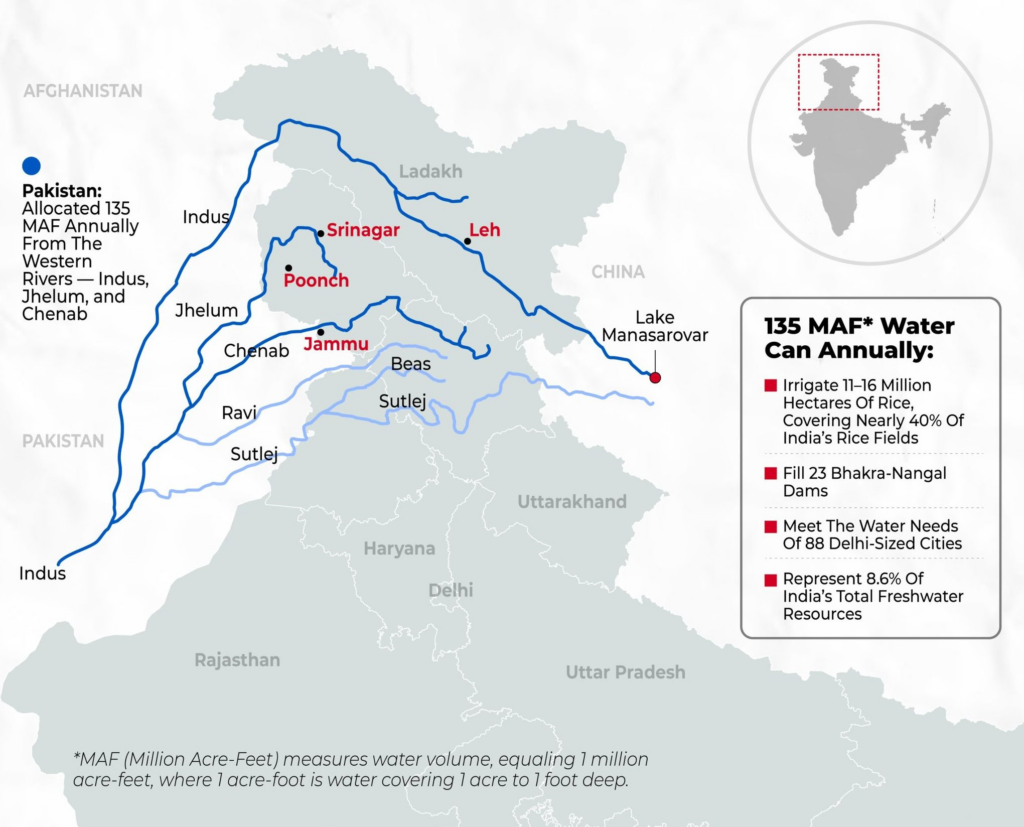
- Pakistan receives 80.52% (167.2 BCM) of the Indus waters via the Western rivers, while India gets only 19.48% (40.4 BCM) from the Eastern rivers.
- Pakistan claims a 90% drop in Chenab River flow, leading to a 20% water shortfall for Kharif crops and posing risks to its agriculture-driven economy.
- Amid climate change and dwindling water resources, Pakistan may face major economic challenges if India suspends or withdraws from the Indus Waters Treaty.
- For India to fully suspend the Indus Waters Treaty and utilise the 167.2 billion cubic metres of water, it requires large-scale storage and water management systems.
Post the Pahalgam terror attack, one of the first diplomatic decisions taken by India under the chairmanship of the Prime Minister in the Cabinet Security meeting was that India would be putting the Indus Waters Treaty in abeyance. This means that the Western rivers like Indus, Jhelum, and Chenab, which were allocated to Pakistan, would now be suspended, and it is up to the Indian government to decide what action to take. This would create a massive economic loss for Pakistan.
Since then, there has been a lot of discussion regarding the Indus Waters Treaty. It is important to understand that the Indus Waters Treaty was first signed on 19 September 1960 by India and Pakistan, and the deal was approved by the World Bank. In the agreement, it was decided that the water allocation would be such that the Eastern rivers, Ravi, Beas, and Sutlej, would be allocated to India exclusively, whereas the Western rivers, Indus, Jhelum, and Chenab, would be allocated to Pakistan. India was allowed non-consumptive use such as irrigation, hydropower, and navigation.
Along with that, financial compensation was also agreed upon, wherein India agreed to contribute approximately £62 million to help Pakistan build canals and reservoirs to utilize the waters of the Western rivers. The treaty also provided for the establishment of the Permanent Indus Commission, a bilateral commission for dispute resolution and cooperation, along with mandatory annual meetings and inspections.
For dispute resolution, a three-tier mechanism was established: starting from commission-level talks, followed by a Neutral Expert, and finally the Court of Arbitration. The Indus Waters Treaty of 1960 is considered one of the most generous water treaties ever signed, especially considering that India, being the upper riparian state, agreed to such terms. This treaty excessively benefited Pakistan and had very little to offer India.
Unfair Treaty Favouring Pakistan
The numbers speak for themselves. The Western rivers allocated to Pakistan consist of 167.2 billion cubic metres of water, and Pakistan’s share of the total Indus water stands at 80.52%, whereas the Eastern rivers allocated to India comprise only 40.4 billion cubic metres, giving India just 19.48% of the total water. This strategic imbalance is why experts like Brahma Chellaney have called the treaty completely one-sided, excessively generous, and a deal that should have been suspended long ago. The treaty provides Pakistan with abundant water resources, supporting its agrarian economy, while at a time when India faces desertification and climate change impacts, it continues to give away a critical resource to a hostile neighbour.
The abeyance came as a non-kinetic diplomatic response following the terror attack. However, for India to fully suspend the Indus Waters Treaty and utilise the 167.2 billion cubic metres of water, it requires large-scale storage and water management systems. This includes the construction of dams and river-linking projects. India is currently constructing more than 34 dam projects on the Western rivers of the Indus basin, but as of now, many of them are yet to be completed.
Therefore, although India has suspended the treaty with Pakistan in principle, it does not yet have a permanent infrastructure to divert or store those waters. This remains a major challenge. As a result, some of the water from the Chenab River was released to Pakistan three days ago, leading to a flash flood-like scenario. Meanwhile, the Jhelum River has seen reduced water flow. These developments have significant ramifications for Pakistan, whose agrarian economy heavily depends on the Indus waters.

Impact on Pakistan
Following the decision the Indian government has taken of keeping the Indus Water Treaty under abeyance, this has had massive consequences for Pakistan. Pakistan has stated that there is a 90% reduction in the flow of the Chenab River, the same river which also flows into Pakistan. As a result, Pakistan has said that the Kharif crops being sown across the country are facing a 20% deficiency in water, which may impact its agriculture-focused economy.
The Pakistani government has also claimed that India has stopped the flow from the Kishanganga and Baglihar dams, and that all major tributaries and rivers of the Chenab flowing into Pakistan are now completely dried up. However, last week, there was also a large inflow of water that the Indian government released.
Currently, the Indian government is not sharing hydrological data with the Pakistani government. India also does not have a permanent alternative to store this water, so what India does is reduce the flow at intervals and then eventually increase it, which is leading to huge problems inside Pakistan. Sometimes this can even lead to flash floods.
This is a major strategic move by the Indian government against Pakistan, as the latter’s economy is greatly focused on agriculture. Amidst climate change and already-depleting water resources in the Indian subcontinent, Pakistan is likely to face significant economic challenges in the future if the Indus Water Treaty is kept in abeyance for long by India or withdraws from the treaty.
Pakistan has termed this an act of war and stated that it will take a decisive response. However, India, as the upper riparian state, retains the right to unilaterally withdraw from the treaty, especially given Pakistan’s continued support for terrorism. Resource sharing can only happen when both countries act responsibly and respect each other’s sovereignty and integrity.
References:
- https://www.orfonline.org/expert-speak/indus-treaty-in-abeyance-a-strategic-pause-not-a-legal-breach
- https://www.thehindu.com/news/national/suspension-of-the-indus-waters-treaty-what-are-the-implications-for-india-and-pakistan/article69486740.ece
Aayush Pal is a freelance writer on contemporary geopolitical developments. The views expressed in his work are entirely his own.
